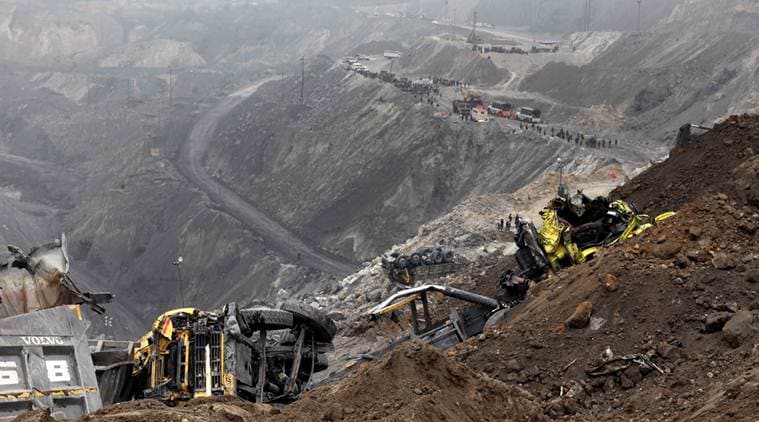Date | Jan 03, 2017:

Rescued oparation continues , accident caused due to Rajmahal mine tragedy at Goda district at Jharkhand. Express photo
Thursday night’s mine collapse at Eastern Coalfields Ltd’s Lal Matia coal mine in Jharkhand rounds up one of the deadliest years for those toiling deep in the bowels of the earth. The 17 mine worker deaths reported till January 1 sharply push up the mining fatality count for this year, which stood at 65 across both coal and non-coal mines during just the first six months of this year, for which latest data is available — translating into a fatality every three days. More than a dozen workers remain trapped.
In a sector whose safety record is far from inspiring, at least 122 people more were documented to have met with a serious accident during this period, which translates into a serious accident every one and a half days. With a fatal accident every three days, mining is arguably the most dangerous profession in India, alongside ship-breaking.
The numbers for July-December 2016, which would include the Lal Matia mining accident, could well push the fatalities this year to a record high.
Major accidents this year include one in the early hours of May 28 at the Turamdih Uranium Mine near Jamshedpur, run by the State-owned Uranium Corporation of India Ltd (UCIL), killing three miners after they accidentally got buried under the wet radioactive slurry they were reportedly clearing at a depth of over 250 metres. The Turamdih mine is located 6 km from Jamshedpur in Jharkhand.
Earlier, on April 14, three workers of Singareni Collieries Company Ltd (SCCL) were crushed to death when a portion of the roof of a structure inside the coal mine collapsed on them when they came in to drink water around mid-day. Of the four workers at the Shanthikhani main site near Mandamarri, Telangana, one escaped with minor injuries.
Eastern Coalfields, where the latest accident has taken place, is a subsidiary of State-owned Coal India Ltd (CIL), the world’s largest coal miner.
Industry insiders, including senior CIL officers, concede that official number of fatalities could be much lower than the actual deaths taking place deep inside mines.
There are two other serious issues. One, that though employees of State-owned coal firms are governed by the same set of rules as, say, those of Air India, payout rates in case of accidents are low. The compensation for injuries or death ranges between Rs 5.4 lakh and Rs 8.5 lakh, rarely crosses Rs 10 lakh, and is under process for long. The other is that a number of those who perish are contract workers who, or their immediate families, have practically no safety net apart from this payout.
Records also show that a majority of mining accidents in India involve roof and side wall collapses of a mine. The Ministry of Mines has termed the Lal Matia accident an “unprecedented” event. “Prima facie, it is observed that the incidence is unprecedented, since an area of 300 m length by 110 m wide solid floor of the Over Burden dump area has slid down by about 35 m involving around 9.5 million cubic metres of earth material. This could be due to failure of the bench edge along the hidden fault line/slip,” the ministry said in a December 30 statement.
Witnesses on the ground have confirmed that there were warning signals in terms of a cascade fall of boulders at least three hours before the cave-in at the open-cast project in Jharkhand’s district Godda.
While official statistics show that average fatality rates and the number of serious accidents have been coming down — the Directorate General of Mines Safety figures suggest annual fatality rate is 0.21 in India (taking into account the total number of mines), down from 0.36 about five years ago — that is cold comfort for policymakers considering that an average seven lives were lost in 2015 for extracting 100 million tonnes of coal. Considering last fiscal’s coal production target of 700 million tonnes, that works out to nearly 50 for 12 months.
An uptick in the economy, experts fear, could invariably lead to increased pressure on Indian mining utilities to ramp up output, prompting calls for re-evaluating the safety of mine workers.
India produces 89 minerals operating 569 coal mines, 67 oil & gas mines, 1,770 non-coal mines, and several more small mines, running into over a lakh. About one million people on an average are employed on a daily basis at these mines, with the sector contributing about 5 per cent to the country’s GDP.
Between 2009 and 2013, there were 752 documented fatalities in mining operations in India, according to the Office of Directorate General of Mines Safety, Ministry of Labour and Employment. These included accidents at mines run by CIL, Neyveli Lignite Corporation and Singareni Collieries.
One of the reasons why the Coal Mines (Nationalisation) Act was enacted in 1973, taking over private sector mines, was the poor safety record of mines. Lack of investment in coal mines is cited as one of the main reasons for the high casualties. Accidents during surface transport by heavy machinery in open-cast mines, apart from the use of explosives, are the other key reasons.
(Source: http://indianexpress.com/)